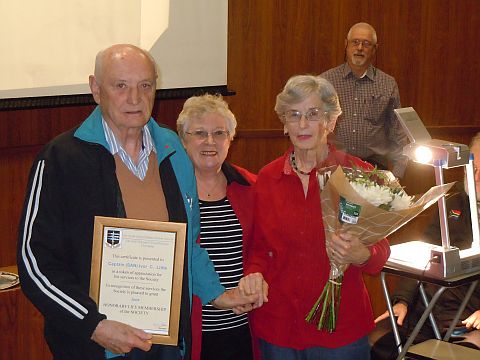

 The South African
The South African
The 48th annual general meeting of the SA Military History Society took place on Thursday, 10 April 2014 at the Ditsong National Museum of Military History, after a very successful and enjoyable year. The Society in total now has a membership of 538. In Johannesburg, attendance at meetings has been excellent, with an average attendance at meetings of 82 people, 56 members and 26 guests. Good attendances have also been reported from Durban and Port Elizabeth, as these branches are steadily increasing their memberships.
Malcolm King was elected Chairman for the next two years, and the rest of the committee were reappointed to office nem can. A certificate of Honorary Life Membership and a small gift as a token of appreciation, were presented to Captain Ivor Little, in recognition of his outstanding service to the Society over the past ten years as Scribe, as well as having served for two years as Chairman. A bouquet of flowers was presented to Anne Little in recognition of her contribution over the years.

After the AGM, the prizes for the best lectures of 2013 as voted for by Society Members were presented by Colin Dean. The George Barrell Prize for the best Curtain Raiser went to Past Chairman Bob Smith for his talk on 'Boer Life on St Helena', about the prisoner of war camps on that remote island. Bob went above and beyond the call of duty to research this, as he organized a group of members to embark on a cruise to the island to see it all for themselves. Well done Bob!
The Felix Machanik Prize for the best Main Lecture was awarded to Nick Cowley for his talk on 'Uncle Sam's Songs of Strife', music of the Civil War, illustrated by musical interludes. For most members, this was a novel approach to a topic of great interest, and much appreciated.
For the year ahead, the Society has a full programme of lectures, and outings, plus some film shows to be screened by The Majestic Historical Film Society at Ditsong National Museum of Military History. These movies will concern events that took place during the First World War, and it is hoped to screen movies quarterly on the theme of First World War events each year during the centennial commemorations until the end of 2018. In addition, the Society is working closely with the Museum to arrange a programme of concerts and other events as part of the South African remembrance of the Great War and South Africa's role in it.
On Saturday, 22 March 2014, the Johannesburg Branch of the South African Military History Society made its long overdue trip to Smuts House Museum, on the farm 'Doornkloof' outside Irene, Pretoria. It was overdue, because the excursion had to be postponed on several occasions due to various reasons, including floods. The old house on the farm served as the home where one of South Africa's favourite sons, Jan Christian Smuts, his wife 'Issie', and their family lived for many years. Originally prefabricated in Britain and taken to India by the British Army, then brought to South Africa to serve as an officers' mess, the house was bought by Smuts for the price of £300. The Smuts family moved into the house in 1909. After the general passed away in the big house in 1950, Mrs Smuts lived there until she died in 1954.
The Society was accompanied on the tour of the house by the local guide, Dennis Bredenkamp, a veritable fountain of knowledge and enthusiasm! (Some of us know him from the East Rand Society). He certainly brought alive the house and its contents, and the consensus was that this was a happy home, a place where the great statesman could enjoy the simple life of a farmer, father and grandfather. It was also obvious that the Smuts family was indifferent to luxury and preferred a quiet life away from the affairs of state. Here Smuts could also indulge in his love of botany and philosophy. General Smuts was not only a prolific writer, producing numerous letters every day, but also an avid reader, said to possess a photographic memory. The huge library is evidence of his love for knowledge. Dennis also pointed out interesting facts, including a telephone in the bathroom, which would have been a first for that time. The huge elephant tusks in the entrance hall were a gift from his troops in German East Africa, and served as a gong!
Apart from some maintenance work carried out in the house during our small party's visit (the house demands a lot of work, and is maintained by volunteers), the feeling was that this was a morning well spent. It concluded in the adjacent tea garden, 'Ouma se Kombuis', where the party enjoyed a wonderful and sumptuous lunch and some splendid home-made ginger beer! All in all, it was a great outing, and good time spent in the company of gracious friends and Society members. To have wonderful weather as well was a bonus, especially after the torrential rains of the previous weeks.
Return to Journal Index OR Society's Home page
South African Military History Society / scribe@samilitaryhistory.org